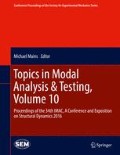Abstract
Recent advances in additive manufacturing technology have made feasible the use of materials such as titanium and high-temperature nickel alloys in the construction of complex parts intended for production through techniques such as direct laser melting or direct laser sintering. These parts can be manufactured at a level of quality suitable not only for prototyping, but even for use as flight hardware. However, the evaluation of material properties is a challenge; melted metals will not retain the same properties as an equivalent cast metal, and factors such as part geometry, print density, and any post-processing techniques used will all influence the material properties of a given component. This paper uses modal analysis to update the isotropic material properties of metal components which are representative of flight hardware within the subsystems of a liquid rocket motor. Two different materials are examined: Ti 64 titanium alloy and INCONEL 718 nickel alloy.
Access this chapter
Tax calculation will be finalised at checkout
Purchases are for personal use only
Notes
- 1.
Under some definitions, “3D printing” refers specifically to the manufacture of plastic parts, though it is often used as a catch-all term for any sort of additive manufacturing process. Here, the abbreviation “AM” is used to encompass all possible additive processes, and the more specific “DMLS” abbreviation is used to refer to the specific process in use for this paper.
References
Electro optical systems GmbH, Design Rules for DMLS
Special metals, INCONEL alloy 718, 2007
Electro optical systems GmbH, Material Data Sheet, EOS Titanium 64, October 2011
Kammer, D.C.: Sensor placement for on-orbit modal identification and correlation of large space structures. J. Guid. Control. Dyn. 14(2), 251–259 (1991)
Kammer, D.C.: Sensor set expansion for modal vibration testing. Mech. Syst. Signal Process. 19(4), 700–713 (2005)
Allen, M.S., Ginsberg, J.H.: A global, single-input multi-output (SIMO) implementation of the algorithm of mode isolation and application to analytical and experimental data. Mech. Syst. Signal Process. 20(5), 1090–1111 (2006)
Acknowledgements
This material is based upon work supported by the National Science Foundation Graduate Research Fellowship under Grant No. DGE-1256259. Any opinion, findings, and conclusions or recommendations expressed in this material are those of the authors(s) and do not necessarily reflect the views of the National Science Foundation.
Author information
Authors and Affiliations
Corresponding author
Editor information
Editors and Affiliations
Appendix
Appendix
The first ten mode shapes and frequencies of the INCO 718 component obtained from a finite element analysis are shown in Fig. 19.9. A top-down viewpoint is used, and only the lowermost nodes in the structure are included. All of the modes are “flapping modes” of various order, and all but modes nine and ten occur as pairs of “close” natural frequencies.
Rights and permissions
Copyright information
© 2016 The Society for Experimental Mechanics, Inc.
About this paper
Cite this paper
Schoneman, J.D., Allen, M.S. (2016). Modal Test and Parameter Updating of Metal Laser Sintered Components. In: Mains, M. (eds) Topics in Modal Analysis & Testing, Volume 10. Conference Proceedings of the Society for Experimental Mechanics Series. Springer, Cham. https://doi.org/10.1007/978-3-319-30249-2_19
Download citation
DOI: https://doi.org/10.1007/978-3-319-30249-2_19
Published:
Publisher Name: Springer, Cham
Print ISBN: 978-3-319-30248-5
Online ISBN: 978-3-319-30249-2
eBook Packages: EngineeringEngineering (R0)


